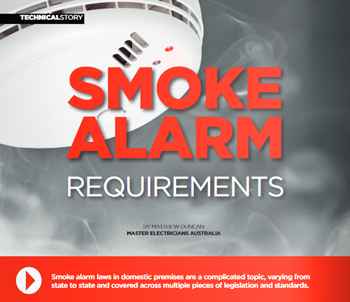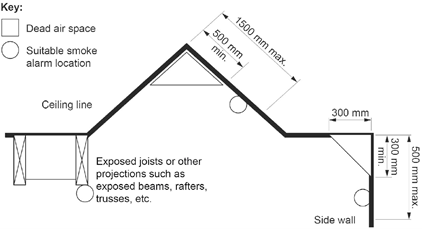Smoke alarm requirements for every state and territory
 Smoke alarm requirement laws in domestic premises are a complicated topic which vary from state to state and are covered across multiple pieces of legislation and standards.
Smoke alarm requirement laws in domestic premises are a complicated topic which vary from state to state and are covered across multiple pieces of legislation and standards.
There are two common documents that apply to all of Australia, The National Construction Code (NCC) formally called the Building Code of Australia (BCA) and the manufacturing standard AS 3786:2014 – Smoke alarms using scattered light, transmitted light or ionization.
AS/NZS 3786 is the manufacturing standard for smoke alarms and is called up in the NCC as the required minimum for smoke alarms to comply with. It contains manufacturing specifications for mandatory and optional components of a smoke alarm, such as power supplies, indicator lights or interconnect functions, as well as the testing requirements to certify the alarm complies. It does not however, contain any installation or in-service testing instructions, these are left to the NCC and various state and territories legislations.
First let’s address the NCC requirements as they are national and underpin the individual state or territories requirements. These rules are specific to a Class 1a dwelling, i.e. a house or duplex, but are also suitable for a Class 2 (apartment) , though a Class 2 may opt to have a different type of system like detectors to a fire indicator panel for the whole building. Be aware that a Class 1b (i.e. boarding house, budget accommodation, backpackers, communal short-term rental) dwelling has substantially different requirements, e.g. emergency lighting
Smoke alarms must be powered from the consumers electricity supply where one is connected to the building. If there is more than one alarm, they are required to be interconnected. The NCC requires alarms to be located as follows.
- In any story containing a bedroom – in every corridor or hallway associated with a bedroom, or if there is no corridor or hallway, in an area between the bedrooms and the remainder of the building.
- On each other story not containing a bedroom, usually along an egress path, even if that storey only contains carparking, bathrooms or laundries.
- When located on a ceiling (preferred method) a min of 300mm away from the corner junction of the wall and ceiling, and when on a sloping ceiling, between 500mm and 1500mm away from the highest point and apexes of the ceiling.
- Where a ceiling installation is not possible, the alarm may be installed on a wall between 300mm and 500mm from the junction of that wall and the ceiling

In some states, fire safety legislation may require additional works over and above the N.C.C. requirements. In some cases, they are retrospective to existing properties.
Victoria
All homes must have a smoke alarm on every level. If built before August 1, 1997 they may be battery powered. If built or majorly renovated after then, they must be connected to mains supply. Homes constructed or major renovation after 1st May 2014 are required to have interconnected alarms fitted.
Tasmania
After August 1, 1997, new residential buildings and residential buildings that had renovations that necessitated a building permit must have a minimum of one smoke alarm on each level and be connected to mains supply. Since May 1, 2016 all domestic rental properties are required to have smoke alarms fitted to every level and may be mains powered or by a 10yr non removable battery
South Australia
Since January 1, 1995 all new homes have been required to have mains powered smoke alarms fitted. Homes built before 1995 require an alarm to be installed but this may be of the type with a removable battery. In addition, any transfer of ownership after February 1, 1998 required that a 240v alarm or one powered by a 10 year non removable battery be installed within six months. From May 1, 2014, smoke alarms have been required to be interconnected in all new dwellings. In existing buildings approved before May 1, 2014 any extension or addition which requires more than one smoke alarm must have those alarms interconnected however there is not a requirement to interconnect to alarms in the existing building. Smoke alarms in subsequent extensions will be required to interconnect to any alarms in extensions approved after May 1, 2014.
Northern Territory
Hard wired alarms have been required since January 7, 1998. If the home was built before then, you must install an alarm, however it may be battery powered. Since November 1, 2011, photoelectric alarms are the only approved type for the NT. Where a battery alarm is installed in an older property it must be a 10 year non removable battery type. The NT also requires installation in caravans and other movable dwellings.
NSW and ACT
Since May 1, 2006 all homes including caravans and moveable dwelling, have been required to have smoke alarms installed or retrofitted to every level of the house in accordance with the NCC.
Western Australia
Since July 1, 1997 mains powered smoke alarms have been mandatory for all new buildings or extensions and from October 1, 1997 mains powered alarms have been mandatory to be fitted to any property being rented, hired or sold (including transfer of ownership). Battery powered smoke alarms may be installed without local government approval where there is no hidden space in the existing dwelling in which to run the necessary wiring for hard wired smoke alarms and there is no appropriate alternative location, for example where there is a concrete ceiling a 10 year non removable battery must be used. Interconnection to other alarms is required for homes approved for construction after May 1, 2015. Interconnection is not required for any premises built before May 1, 2015.
Queensland
Has introduced the most stringent laws in the country. Since January 1, 2017 all homes approved for construction or substantially renovated are required to have additional alarms fitted to each bedroom and interconnected throughout the entire house. Since January 1, 2022 it is mandatory to retrofit smoke alarms to each bedroom and interconnect to the rest for the house for all rental properties and properties sold. This same requirement will be extended to all properties by January 1, 2027. Alarms retrofitted into existing properties may be powered by a 10y non removable battery or hard wired unless it is a significant renovation then it must be hard wired. Only photoelectric alarms have been permitted since January 1, 2017.
As you can see there are a lot of varying requirements depending on a buildings age and the state/territory. If you are unsure what your installation needs please contact a professional to help you design your system. Remember only working smoke alarms save lives.
Written by Matthew Duncan, Master Electricians Australia for Circuit Magazine.